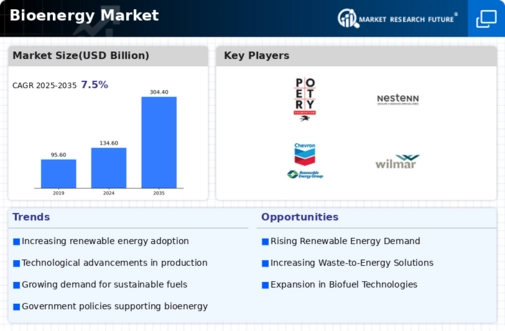Market Analysis
In-depth Analysis of Bioenergy Market Industry Landscape
The bioenergy market, characterized by the production and utilization of energy derived from organic materials, is influenced by various market dynamics. These dynamics encompass factors such as supply and demand, government policies, technological advancements, and environmental concerns. Understanding these dynamics is crucial for stakeholders involved in the bioenergy sector to make informed decisions and navigate the market effectively.
One significant aspect of the bioenergy market dynamics is the fluctuation in supply and demand. The availability of biomass feedstock, which includes crops like corn, sugarcane, and switchgrass, as well as organic waste materials, directly impacts the production of bioenergy. Weather conditions, agricultural practices, and competing uses of biomass, such as food production, also influence supply levels. On the demand side, factors such as energy prices, government incentives, and consumer preferences for renewable energy sources drive the uptake of bioenergy technologies.
Government policies play a pivotal role in shaping the bioenergy market landscape. Many countries have implemented renewable energy targets, carbon pricing mechanisms, and subsidies to promote the use of bioenergy and reduce greenhouse gas emissions. These policies create a favorable regulatory environment for bioenergy projects and incentivize investments in research and development. Additionally, regulations regarding sustainability criteria for biomass sourcing and emissions standards for bioenergy production influence market dynamics by affecting production costs and market access.
Technological advancements are another key driver of market dynamics in the bioenergy sector. Innovations in biomass conversion technologies, such as biochemical and thermochemical processes, improve the efficiency and cost-effectiveness of bioenergy production. Advancements in biotechnology, genetic engineering, and biomass cultivation techniques enhance the yield and quality of biomass feedstock, further boosting the competitiveness of bioenergy solutions. Additionally, ongoing research and development efforts focus on overcoming technical challenges, such as biomass logistics and storage, to facilitate the widespread adoption of bioenergy technologies.
Environmental concerns, particularly related to climate change and air pollution, shape the demand for bioenergy as a cleaner alternative to fossil fuels. Bioenergy is considered carbon-neutral or even carbon-negative when produced from sustainably managed biomass sources. By displacing fossil fuels in power generation, heating, transportation, and industrial processes, bioenergy contributes to reducing greenhouse gas emissions and mitigating climate change impacts. Furthermore, bioenergy technologies offer potential co-benefits such as improved air quality, waste reduction, and rural development, which resonate with stakeholders seeking sustainable energy solutions.
Market dynamics in the bioenergy sector also reflect broader trends in the energy industry, including shifts towards decentralization, electrification, and digitalization. Distributed bioenergy systems, such as biogas digesters and small-scale biomass power plants, enable local energy production and promote energy independence. Integration of bioenergy with renewable electricity generation technologies, such as wind and solar, supports grid stability and enhances energy security. Moreover, digital innovations, such as smart biomass management systems and blockchain-enabled supply chains, optimize resource allocation and improve transparency in the bioenergy market.
The bioenergy market is influenced by a complex interplay of supply and demand dynamics, government policies, technological advancements, and environmental considerations. Stakeholders in the bioenergy sector must navigate these dynamics strategically to capitalize on opportunities and address challenges effectively. By fostering innovation, promoting sustainable practices, and aligning policies with climate and energy objectives, the bioenergy market can contribute significantly to the transition towards a more sustainable and resilient energy future.







Leave a Comment